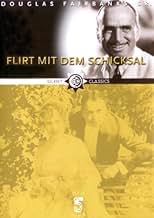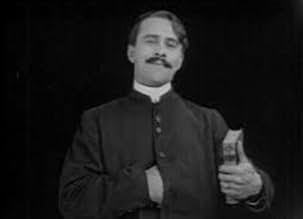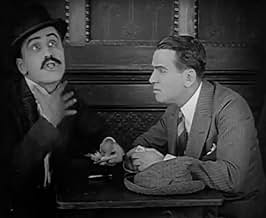Ajouter une intrigue dans votre langueIn the midst of an emotional depression, a man hires a murderer to kill him. But the despair soon passes, and the man must now escape the killer he's hired to end his life.In the midst of an emotional depression, a man hires a murderer to kill him. But the despair soon passes, and the man must now escape the killer he's hired to end his life.In the midst of an emotional depression, a man hires a murderer to kill him. But the despair soon passes, and the man must now escape the killer he's hired to end his life.
- Réalisation
- Scénario
- Casting principal
Avis à la une
This movie, with Douglas Fairbanks in the lead, has a slow start. Although painter Augy does not make a penny, he does not look depressed at all and when he falls in love with the beautiful and rich Gladys he's in seventh heaven. But when Glady's seeks consolation with another man, Augy's heart is broken and does not want to live anymore. After a failed suicide attempt, he hires a contract killer to do him in. From that moment on, it becomes a super fun and comic movie. Fairbanks shows what he's best in and does a lot of stunt work.
When I heard about the Dutch film 'De Surprise', with Jeroen van Koningsbrugge and Georgina Verbaan in 2015, I thought I had already seen the plot earlier. The Surprise has the same theme. This film is based on a story of Belcampo, which was filmed for Belgian television in 1984. But this is not the only movie with that same theme. In 2005, the Czechs made 'Shut up and shoot me'. In 1990 the Finns came with the black comedy; 'I hired a contract killer'. The French also made their own version with 'Up to his ears' in 1965. There is even a Star Trek: Deep Space Nine episode with this theme. Further back, in 1931, the Germans made the slapstick 'Der Mann, the Seinen Mörder Sucht'. But who thinks that 'Flirting with Fate' was the first in 1916 is deceived. It may be the first movie with this plot, but the credits for this original story should go to Jules Verne with his book 'Tribulations of a Chinaman in China', dating back to 1879.
Back to Flirting with Fate. Although Douglas Fairbanks plays the stars of heaven, leading lady, Jewel Carmen, is a bit disappointing. She's just a beautiful face and she hasn't really got charisma. Her friend Phyllis, played by Dorothy Haydel, has a minor role, but clearly has more charisma. In addition, George Beranger, who plays Automatic Joe, deserves a mention. He plays his role as a contract killer excellent.
But apart from the slow start and the flat leading lady this is a very nice movie.
When I heard about the Dutch film 'De Surprise', with Jeroen van Koningsbrugge and Georgina Verbaan in 2015, I thought I had already seen the plot earlier. The Surprise has the same theme. This film is based on a story of Belcampo, which was filmed for Belgian television in 1984. But this is not the only movie with that same theme. In 2005, the Czechs made 'Shut up and shoot me'. In 1990 the Finns came with the black comedy; 'I hired a contract killer'. The French also made their own version with 'Up to his ears' in 1965. There is even a Star Trek: Deep Space Nine episode with this theme. Further back, in 1931, the Germans made the slapstick 'Der Mann, the Seinen Mörder Sucht'. But who thinks that 'Flirting with Fate' was the first in 1916 is deceived. It may be the first movie with this plot, but the credits for this original story should go to Jules Verne with his book 'Tribulations of a Chinaman in China', dating back to 1879.
Back to Flirting with Fate. Although Douglas Fairbanks plays the stars of heaven, leading lady, Jewel Carmen, is a bit disappointing. She's just a beautiful face and she hasn't really got charisma. Her friend Phyllis, played by Dorothy Haydel, has a minor role, but clearly has more charisma. In addition, George Beranger, who plays Automatic Joe, deserves a mention. He plays his role as a contract killer excellent.
But apart from the slow start and the flat leading lady this is a very nice movie.
This is a typical modern comedy starring Douglas Fairbanks, before he began on his path of adventure swashbucklers with "The Mark of Zorro" in 1920. Some of them, such as "Wild and Woolly" (1917), are quite good. "Flirting with Fate", however, is lacking. As fellow commenter wmorrow59 said, the pacing is slow to begin, especially when compared to a film like "Wild and Woolly". It's much too tiresome for a comedy.
The pacing does pick up after Fairbanks's deal with Automatic Joe, though. Finally, Fairbanks employs his acrobatic skill for humor. Hiring an assassin to kill oneself is always a promising plot device, and the resulting irony this time had me chuckling. Giving a receipt for the business transaction is hilarious. On the other hand, the comical intertitles in the style of Anita Loos lack her cleverness. Sometimes they address the audience--or the orchestra, but they seem forced. Loos had worked with Fairbanks on "His Picture in the Papers", "The Mystery of the Leaping Fish", and, later, "Wild and Woolly", giving him his voice. This film could have used her and her husband director John Emerson.
The pacing does pick up after Fairbanks's deal with Automatic Joe, though. Finally, Fairbanks employs his acrobatic skill for humor. Hiring an assassin to kill oneself is always a promising plot device, and the resulting irony this time had me chuckling. Giving a receipt for the business transaction is hilarious. On the other hand, the comical intertitles in the style of Anita Loos lack her cleverness. Sometimes they address the audience--or the orchestra, but they seem forced. Loos had worked with Fairbanks on "His Picture in the Papers", "The Mystery of the Leaping Fish", and, later, "Wild and Woolly", giving him his voice. This film could have used her and her husband director John Emerson.
Douglas Fairbanks is remembered primarily as a swashbuckling hero, the original Robin Hood, Zorro, and Thief of Bagdad, but in his earlier years on screen he appeared in a series of action comedies, and thereby created a template that would be followed by a number of latter-day comedians, notably Harold Lloyd. Young Doug is a bright-eyed and ambitious "go-getter" in these films, much like the character embodied by Lloyd in his great comedies of the '20s. The stories are breezy and light, and usually culminate in a chase. On occasion, as in Wild and Woolly and The Mollycoddle, Doug starts off as a foolish or downright effete character who must take some hard knocks in order to grow up and win the respect of his peers, his girl, and his audience, the basic formula that would be reworked by Lloyd, Buster Keaton, William Haines, and others.
Flirting with Fate is a good example of this sort of comedy, and while I wouldn't rank it with Doug's best work of the period it makes for an entertaining hour's worth of viewing. Here he plays an artist with financial problems, in love with a girl from a much higher social set. One minor drawback for viewers who don't know what's coming is that the early scenes of plot exposition are slowly paced and short on laughs; the supporting actors play it straight, and we wait in vain for the jolly title cards, sight gags, and satirical touches that abound in the later Fairbanks comedies. It takes a while for the comic situation to kick in, and meanwhile a series of depressing setbacks are suffered by our hero, eventually causing him to make an indifferent attempt at suicide. We never really believe that Doug is going to go through with it, but the dark tone of these opening scenes may come as an unwelcome surprise for viewers expecting laughs from the outset.
Doug's inability to kill himself brings about a plot twist that gets thing rolling, and it's a twist that may have been familiar even in 1916: Doug (who is uncharacteristically wimpy in the first portion of this movie) can't face killing himself, so he hires a hit man. Then, of course, his luck changes for the better, and he wants very much to live, only now he must avoid assassination from the killer he hired, who may be disguised. Doug himself dons the world's most unconvincing fake beard and goes to great lengths to elude his assassin. This is where the movie really takes off, and the second half is quite funny. The actor who plays the intended hit man, George Beranger, is terrific, so good he practically steals the show from the nominal star. There are several sequences where Doug fearfully imagines scenarios in which he might get killed, and these deliberately overplayed, melodramatic vignettes -- strikingly performed before black backdrops -- are the highlight of the film, thanks largely to Beranger's burlesque villainy. Douglas Fairbanks would go on to produce far more accomplished films than Flirting with Fate, but those interested in his early work will find this one quite enjoyable, once that crucial twist takes place.
Flirting with Fate is a good example of this sort of comedy, and while I wouldn't rank it with Doug's best work of the period it makes for an entertaining hour's worth of viewing. Here he plays an artist with financial problems, in love with a girl from a much higher social set. One minor drawback for viewers who don't know what's coming is that the early scenes of plot exposition are slowly paced and short on laughs; the supporting actors play it straight, and we wait in vain for the jolly title cards, sight gags, and satirical touches that abound in the later Fairbanks comedies. It takes a while for the comic situation to kick in, and meanwhile a series of depressing setbacks are suffered by our hero, eventually causing him to make an indifferent attempt at suicide. We never really believe that Doug is going to go through with it, but the dark tone of these opening scenes may come as an unwelcome surprise for viewers expecting laughs from the outset.
Doug's inability to kill himself brings about a plot twist that gets thing rolling, and it's a twist that may have been familiar even in 1916: Doug (who is uncharacteristically wimpy in the first portion of this movie) can't face killing himself, so he hires a hit man. Then, of course, his luck changes for the better, and he wants very much to live, only now he must avoid assassination from the killer he hired, who may be disguised. Doug himself dons the world's most unconvincing fake beard and goes to great lengths to elude his assassin. This is where the movie really takes off, and the second half is quite funny. The actor who plays the intended hit man, George Beranger, is terrific, so good he practically steals the show from the nominal star. There are several sequences where Doug fearfully imagines scenarios in which he might get killed, and these deliberately overplayed, melodramatic vignettes -- strikingly performed before black backdrops -- are the highlight of the film, thanks largely to Beranger's burlesque villainy. Douglas Fairbanks would go on to produce far more accomplished films than Flirting with Fate, but those interested in his early work will find this one quite enjoyable, once that crucial twist takes place.
Le saviez-vous
- GaffesWhen Augy is escaping a police officer by jumping into a car, the camera is visible in the car's front window.
- ConnexionsFeatured in Douglas Fairbanks: Je suis une légende (2018)
Meilleurs choix
Connectez-vous pour évaluer et suivre la liste de favoris afin de recevoir des recommandations personnalisées
Détails
- Durée57 minutes
- Couleur
- Mixage
- Rapport de forme
- 1.33 : 1
Contribuer à cette page
Suggérer une modification ou ajouter du contenu manquant

Lacune principale
By what name was Flirting with Fate (1916) officially released in Canada in English?
Répondre























